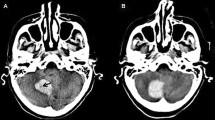Summary
The aim of the present study was to assess the diagnostic accuracy of CT in determining the underlying causes of brain hematomas with a state-of-the art CT. For this purpose, CT and angiographic data of 149 subjects with spontaneous intracerebral hematomas (ICH) were statistically compared in a blind, retrospective study, taking angiography, supported when possible by surgical findings, as providing the correct diagnoses. 5 groups were distinguished on the basis of CT data: 103 patients with isolated deep ICH had normal angiograms; 9 patients with isolated superficial ICH and 8 with deep ICH and intraventricular hemorrhage (IVH) had arteriovenous malformations (AVMs). 4 with this combination showed no angiographic abnormalities, one had an aneurysm. 14 subjects with ICH and subarachnoid hemorrhage (SAH) had a middle cerebral or carotid artery aneurysm; and 10 with ICH, SAH and IVH had also an aneurysm, in 7 on the anterior communicating artery. Sensitivity, specificity, positive and negative predictive values were respectively: for AVMs 100, 96, 77 and 100%; and for aneurysms 96, 100, 100 and 99%. Kendall coefficient was 0.95, indicating close correlation between the two modalities. This study confirms that CT can accurately predict the likelihood, nature and location of vascular ICHs. It indicates whether angiography is necessary or not, and if so, what vascular tree ought to be explored.
Similar content being viewed by others
References
Ojemann RG, Mohr JP (1975) Hypertensive brain hemorrhage. Clin Neurosurg 23:220–244
Ojemann RG, Heros RC (1983) Spontaneous brain hemorrhage. Stroke 14:468–475
Ghoshhajra K, Scotti L, Marasco J, Baghai-Naiini P (1979) CT detection of intracranial aneurysms in subarachnoid hemorrhage. AJR 132:613–616
Liliequist B, Lindqvist M, Valdimarsson E (1977) Computed tomography and subarachnoid hemorrhage. Neuroradiology 14: 21–26
Scotti G, Ethier R, Melancon D, Terbrugge K, Tchangs S (1977) Computed tomography in the evaluation of intracranial aneurysms and subarachnoid hemorrhage. Radiology 123:85–90
Van Gijn J, Van Dongen KJ (1982) The time course of aneurysmal hemorrhage on computed tomograms. Neuroradiology 23: 153–156
Hayward RD, O'Reilly GVA (1976) Intracerebral hemorrhage. Accuracy of computerized axial scanning in predicting the underlying pathology. Lancet I:1–4
Freedman LS (1987) Evaluating and comparing imaging techniques: a review and classification of study designs. Br J Radiol 60:1061–1071
Cohen J (1960) A coefficient of agreement of nominal scales. Educ Psychol Measur 20:37–46
McCormick WF, Rosenfield DB (1973) Massive brain hemorrhage: a review of 144 cases and an examination of their causes. Stroke 4:946–954
Loes DJ, Smoker WRK, Biller J, Cornell SH (1987) Nontraumatic lobar intracerebral hemorrhage: CT/angiographic correlation. AJNR 8:1027–1030
Bitoh S, Hasegawa H, Fujiwara M, Sakurai M (1982) Angiographically occult vascular malformations causing intracranial hemorrhage. Surg Neurol 17:35–42
Edwards KR (1977) Hemorrhagic complications of cerebral arteritis. Arch Neurol 34:549–552
Almaani WS, Awidi AS (1982) Spontaneous intracranial bleeding in hemorrhagic diathesis. Surg Neurol 17:137–140
Ruscalleda J, Peiro A (1986) Prognostic factors in intraparenchymatous hematoma with ventricular hemorrhage. Neuroradiology 28:34–37
Little JR, Dial B, Belanger G, Carpenter S (1979) Brain hemorrhage from intracranial tumor. Stroke 10:283–288
Zimmerman RA, Bilaniuk LT (1980) Computed tomography of acute intratumoral hemorrhage. Radiology 135:355–359
Boudouresques G, Hauw JJ, Escourolle R (1979) 318 cases of intracerebral hemorrhage. A pathologic study (in French). Rev Neurol 135:845–865
West CGH, Forbes WSC (1985) Intraventricular blood without parenchymal clot following spontaneous subarachnoid hemorrhage. Neuroradiology 27:254–258
Edner G, Forster DMC, Steiner L, Bergvall U (1978) Spontaneous healing of intracranial aneurysms after subarachnoid hemorrhage. J Neurosurg 48:450–454
Author information
Authors and Affiliations
Rights and permissions
About this article
Cite this article
Laissy, J.P., Normand, G., Monroc, M. et al. Spontaneous intracerebral hematomas from vascular causes. Neuroradiology 33, 291–295 (1991). https://doi.org/10.1007/BF00587808
Received:
Issue Date:
DOI: https://doi.org/10.1007/BF00587808




